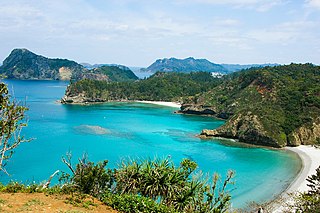
The Ogasawara subtropical moist forests is a terrestrial ecoregion which encompasses the Ogasawara Archipelago of Japan. The Ogasawara Archipelago lies in the Pacific Ocean south of Honshu, Japan's largest island, and north of the Marianas Islands. The ecoregion includes the Bonin Islands and Volcano Islands chains. The islands are volcanic in origin, and have never been linked to a continent. They are home to distinct plants and animals including many endemic species.

Avicennia marina, commonly known as grey mangrove or white mangrove, is a species of mangrove tree classified in the plant family Acanthaceae. As with other mangroves, it occurs in the intertidal zones of estuarine areas.

Pteropus is a genus of megabats which are among the largest bats in the world. They are commonly known as fruit bats or flying foxes, among other colloquial names. They live in South Asia, Southeast Asia, Australia, East Africa, and some oceanic islands in the Indian and Pacific Oceans. There are at least 60 extant species in the genus.
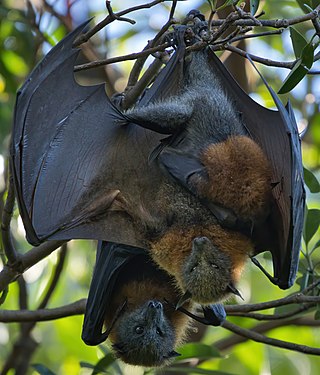
The grey-headed flying fox is a megabat native to Australia. The species shares mainland Australia with three other members of the genus Pteropus: the little red P. scapulatus, spectacled P. conspicillatus, and the black P. alecto. The grey-headed flying fox is the largest bat in Australia.
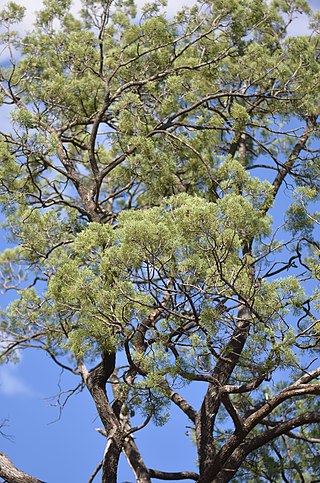
Callitris columellaris is a species of coniferous tree in the family Cupressaceae, native to most of Australia. Common names include white cypress, white cypress-pine, Murray River cypress-pine, Bribie Island pine and northern cypress-pine. Callitris columellaris has become naturalised in Hawaii and in southern Florida.

The spectacled flying fox, also known as the spectacled fruit bat, is a megabat that lives in Australia's north-eastern regions of Queensland. It is also found in New Guinea and on the offshore islands including Woodlark Island, Alcester Island, Kiriwina, and Halmahera.
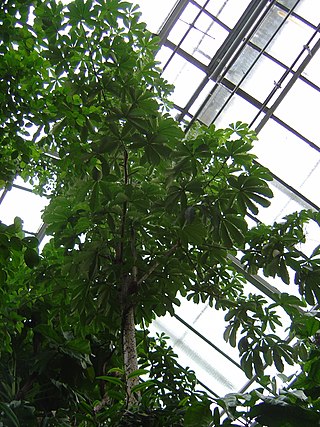
Bombax buonopozense, commonly known as the Gold Coast bombax or red-flowered silk cotton tree, is a tree in the mallow family. It is also known in the Dagbani language as Vabga.

The black-eared flying fox, species Pteropus melanotus, is a bat of the family Pteropodidae (megabats). Also known as Blyth's flying fox, it is found on the Andaman Islands and Nicobar Islands (India), and in Sumatra (Indonesia). A population on Christmas Island, which is critically endangered, has been placed as a subspecies of this population, although it may be a distinct species. Pteropus natalis.
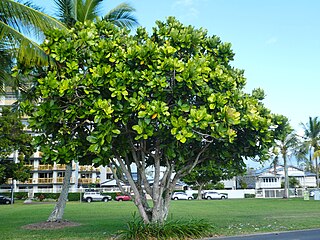
Barringtonia asiatica, also known as fish poison tree, putat or sea poison tree, is a species of Barringtonia native to mangrove habitats from islands of the Indian Ocean in the west to tropical Asia and islands of the western Pacific Ocean.
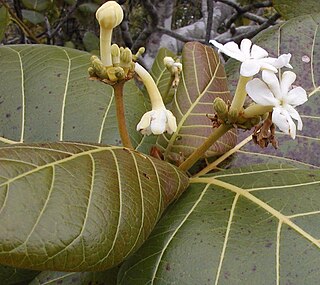
Guettarda speciosa, with common names sea randa, or zebra wood, is a species of shrub in the family Rubiaceae found in coastal habitats in tropical areas around the Pacific Ocean, including the coastline of central and northern Queensland and Northern Territory in Australia, and Pacific Islands, including Micronesia, French Polynesia and Fiji, Malaysia and Indonesia, Maldives and the east coast of Africa. It reaches 6 m in height, has fragrant white flowers, and large green prominently-veined leaves. It grows in sand above the high tide mark.

Elaeocarpus bancroftii, commonly known as Kuranda quandong, Johnstone River almond, ebony heart, grey nut, or nut tree is a large rainforest tree in the family Elaeocarpaceae which is endemic to Queensland. It has coriaceous leaves, attractive white flowers and relatively large fruit containing an edible kernel.

Stenocarpus cryptocarpus, commonly known as the giant-leaved stenocarpus, is a species of flowering plant in the family Proteaceae and is endemic to north Queensland. It is a tree with buttress roots at the base, simple, mostly elliptical adult leaves, groups of cream-coloured flowers and narrow oblong follicles.

Planchonella cotinifolia is an Australian tree in the family Sapotaceae. The common names include small-leaved plum, yellow lemon and small-leaved coondoo. It occurs in the drier rainforests from the Richmond River, New South Wales to the Wenlock River in tropical Queensland.

Harpullia arborea, commonly known as Cooktown tulipwood in Australia, is species of flowering plant in the family Sapindaceae is native to the Indian subcontinent, Sri Lanka throughout Mainland Southeast Asia and Malesia to Queensland in Australia and the Western Pacific. It is a tree with paripinnate leaves with 6 to 10 leaflets, small pink or pale green flowers arranged in leaf axils or on old woody stems, and orange-yellow to red capsules containing shiny black seeds.
Planchonella reticulata is a flowering plant in the sapodilla family, Sapotaceae. It is a shrub or tree endemic to east-central New Caledonia. The specific epithet refers to the reticulate venation on the leaves.

The Christmas Island flying fox or Christmas Island fruit bat, as the name suggests, is a flying fox endemic to Christmas Island. It is unclear if it should be considered a distinct species, or a subspecies of the black-eared flying fox. It may descend from a population of island flying foxes from Pulau Panjang near Java.

The wildlife of Christmas Island is composed of the flora and fauna of this isolated island in the tropical Indian Ocean. Christmas Island is the summit plateau of an underwater volcano. It is mostly clad in tropical rainforest and has karst, cliffs, wetlands, coasts and sea. It is a small island with a land area of 135 km2 (52 sq mi), 63% of which has been declared a National park. Most of the rainforest remains intact and supports a large range of endemic species of animals and plants.

Lunasia amara is the only species of flowering plant in the genus Lunasia of the family Rutaceae, and is native to Malesia, New Guinea, and Queensland. It is a dioecious shrub with simple leaves and head-like clusters of small flowers, the female flowers with larger petals than the male flowers. The fruit has up to 3 follicles joined at the base, each containing a single seed.
Planchonella torricellensis is a tree in the family Sapotaceae. It is native to Maluku, the Lesser Sunda Islands, New Guinea, Fiji, Niue, the Samoan Islands, Tonga, the Tuamotus, and Wallis and Futuna.
















